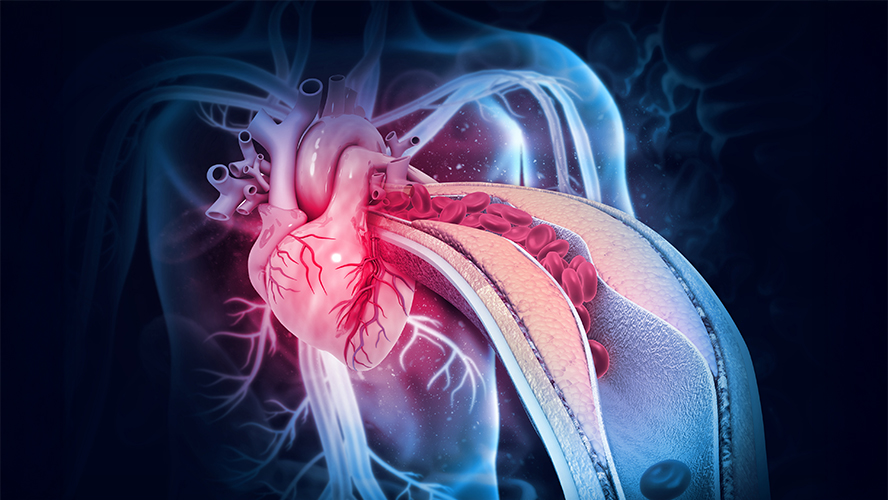
Atherosclerosis—the buildup of cholesterol (called plaques) and inflammation in artery walls—is a leading cause of heart disease and stroke. Researchers at UHN, led by Dr. Kathryn Howe, are studying how the endothelium—the thin layer of cells lining blood vessels—helps drive this process. The team developed the first experimental model to track how endothelial cells (ECs) communicate in organisms and identified EC communication signals that drive carotid artery plaque instability.
ECs help regulate inflammation and blood flow by releasing tiny particles called extracellular vesicles (EVs). These EVs carry messages in the form of proteins, fats, and genetic material. This dynamic cell-to-cell communication may help drive both plaque development and its sudden complications, such as heart attack or stroke.
However, little is known about these EVs’ biological cargo, their cellular origin or destination, and their functional roles in human plaque formation. In addition, tracking EV transfer from ECs in real time remains challenging. Two studies from Dr. Howe’s team delve into these issues and work to overcome these limitations.
In a study in the journal Circulation Research, the team generated a new preclinical model that uses a glowing green marker to follow EC-derived EVs in real time. This offers a powerful new way to track how EVs move and act within blood vessels—especially in developing plaques—providing a tool for studying EC-driven conditions such as stroke, heart failure, diabetes, cancer metastasis, and aging.
In a second study, published in the journal Arteriosclerosis, Thrombosis, and Vascular Biology, the team analyzed EVs from human carotid artery plaques—where plaque buildup in neck arteries can lead to stroke. In addition to impeding blood flow, the plaques can also become unstable and rupture, releasing material that obstructs an artery and leads to a heart attack or stroke.
The team examined EVs from human carotid plaques, comparing samples from patients with and without symptoms of stroke. Using RNA sequencing and protein analysis, they examined EV cargo and traced their origins and destinations. They found more EVs in plaques than in surrounding tissue—especially in symptomatic patients. These EVs carried different microRNAs and proteins depending on whether plaques were stable or prone to rupture.
In symptomatic plaques, EVs showed more complex communication with nearby cells, particularly endothelial cells, and appeared to promote new blood vessel growth—a process linked to plaque instability.
These findings suggest that EVs help drive disease progression and could be targets for new treatments to prevent stroke and other cardiovascular events. Together, these studies highlight EVs as important drivers of atherosclerosis and introduce a new model to study their role.
For the Circulation Research study:
Mandy Kunze Guo, Doctoral Candidate at UHN and the Institute of Medical Science at the University of Toronto, is the first author of the study.
For the Arteriosclerosis, Thrombosis, and Vascular Biology study:
Dr. Sneha Raju, Medical Resident and recent Doctoral graduate from UHN and the Institute of Medical Science at the University of Toronto, is the first author of the study.
Dr. Kathryn L. Howe, Scientist at the Toronto General Hospital Research Institute (TGHRI) and Associate Professor in the Department of Surgery at the University of Toronto, is the corresponding author for both studies.
Co-author Dr. Jason Fish, Senior Scientist at TGHRI, collaborates extensively with Dr. Howe and together, they co-supervise several graduate students, including those involved in this research. To see more about their laboratories, see https://howeandfishlabs.com.
Dr. Howe holds the Blair Early Career Professorship in Vascular Surgery (University of Toronto) and is supported by the Canadian Institutes of Health Research (CIHR), the Heart and Stroke Foundation of Canada, Wylie Scholar Award from Vascular Cures (2020-2023), the University of Toronto, Peter Munk Cardiac Centre, and the UHN Foundation.
For a more comprehensive list of funding and list of competing interests, see the manuscripts.
Raju S, Turner ME, Cao C, Abdul-Samad M, Punwasi N, Blaser MC, Cahalane RME, Botts SR, Prajapati K, Patel S, Wu R, Gustafson D, Galant NJ, Fiddes L, Chemaly M, Hedin U, Matic L, Seidman MA, Subasri V, Singh SA, Aikawa E, Fish JE, Howe KL. Multiomic Landscape of Extracellular Vesicles in Human Carotid Atherosclerotic Plaque Reveals Endothelial Communication Networks. Arterioscler Thromb Vasc Biol. 2025 May 29. doi: 10.1161/ATVBAHA.124.322324.
Guo MK, Scipione CA, Breda LCD, Prajapati K, Raju S, Botts SR, Abdul-Samad M, Patel S, Yu G, Dudley AC, Fish JE, Howe KL. Tracking Endothelial Extracellular Vesicles in a Mouse Model of Atherosclerosis. Circ Res. 2025 Jun 6;136(12):1629-1631. doi: 10.1161/CIRCRESAHA.124.326024. Epub 2025 Apr 23. PMID: 40265255; PMCID: PMC12136386.




